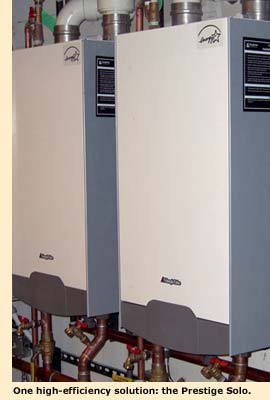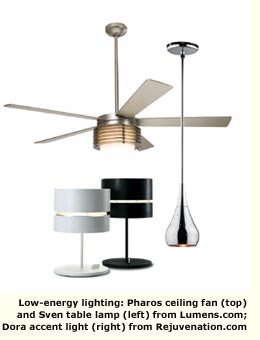Energy Efficiency: Modern Dream, Green Machine - Page 3
Becky San Diego, co-owner of Rebarts Interiors in Burlingame, recommends the Architella Duette Honeycomb Shade by Hunter Douglas. This fashionable window covering uses soft, durable pleated fabrics to create hexagonal cells for an extra layer of insulation. In fact, the sheer shade can increase the R-value of a dual pane window from R-2 to R-6.02, and the opaque version will raise it to 7.73. It also helps cut down outside noise.
"Style-wise, this shade works for contemporary interiors because it's less bulky than earlier models," San Diego says. "It also comes in dozens of colors, including many shades of white."
7. Maximized radiant heating

Radiant boiler upgrade. Similar to how the sun warms outside surfaces on a chilly day, radiant heat technology keeps flooring surfaces consistently toasty without all the billowing hot air of forced-air heat, or the patchy heat of baseboard radiators. Many homeowners today are opting for radiant heat instead of forced-air because it is a quieter, dust-free option and has a quicker response time to thermostat changes. Most Eichlers originally came equipped with radiant heat, and many of their owners are thankful for it.
However, many of these same homes are at a crossroad. While most original Eichler radiant boilers have lasted 50 years and beyond, their efficiency level has steadily declined during later years—from a desirable 85-percent efficiency to as low as 60 percent. Telltale signs of decline include poor heating in areas of the house farthest from the boiler, irregular pressure fluctuations, an unusually hot boiler and boiler room, discoloration or burns on the boiler jacket, and odors in the boiler room.
In addition to the basic mid-priced, workhorse boilers (approximately 85 percent efficiency), the super high-efficiency models (90 percent and higher) are showing a sharp increase in popularity today among eco-conscious owners. For high efficiency, expect to pay $6,500 to $7,000 (and perhaps more), including installation.
After a boiler change out, a 25- to 30-percent (and perhaps greater) gas savings is not uncommon. "It's a long-term investment, but you will reap the benefits immediately," says Mike LaChance of LaChance Radiant Heating.
LaChance also recommends that radiant systems get checked out regularly. "Bi-annual inspections, especially on older units, are recommended for safety and efficiency," he says. "Because even minor problems can later lead to bigger concerns, which usually become more costly in the long run."
8. Lighting that saves

Long-life light bulbs. To reduce energy consumption and save money, replacing your lighting fixtures can make a huge difference. Consider swapping out the fixtures you use most often with Energy Star models, which use 75 percent less energy than standard incandescent light bulbs. The five highest use fixtures in a home are typically the kitchen ceiling lights, the living or family room lamps, and outdoor porch or post lamps.
Energy Star-qualified lighting uses compact fluorescent lamps (CFLs) that give off bright, warm light. CFLs have a lifespan of 6,000 hours instead of 1,000 hours like that of traditional incandescent light bulbs.
Many lighting manufacturers are creating fixtures that hold new technology: GU24 florescent bulbs. These Energy Star-approved bulbs don't have the usual screw base, but instead have two bayonets protruding from the bottom. These insert into matching holes in the fixture's socket and twist to lock into place. Twist and pull, and the bulb also comes right out of the socket. The benefit of the GU24 innovation is that any fixture with a GU24 socket can now take any bulb with a GU24 connection. That means a fixture is not limited to its original type of light source.
For mid-century home aficionados, lighting company Rejuvenation of Portland, Oregon offers period-style fixtures that fit GU24 bulbs. "As a lighting company, part of what we struggled with over the years has been having to modify the look of our fixtures to fit pin-based compact fluorescents," says Tony Pensca, director of marketing. "With this new technology, the GU socket and base fits into our existing fixtures, giving our customers a lot more options."
LED (light-emitting diode) lights are another up-and-coming option for today's home. They have an incredibly long life, lasting 50,000 to 100,000 hours. Although there aren't yet many residential fixtures that use LEDs, they are available for recessed applications and indirect light above kitchen cabinetry, according to Ken Plumlee, co-owner of Lumen's Light + Living in Sacramento. Plumlee also recommends putting dimmer controls on all overhead lights to extend the life of the bulb.




